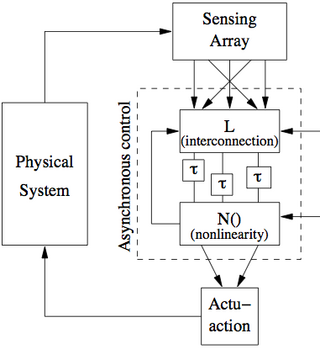Networked Feedback Systems in Biology: Difference between revisions
From Murray Wiki
Jump to navigationJump to search
| Line 36: | Line 36: | ||
== Publications == | == Publications == | ||
* {{Dun_08-natgen}} | * {{Dun_08-natgen}} | ||
* {{FDM09-acc}} | |||
* {{FM08-cdc}} | * {{FM08-cdc}} | ||
* E. Franco, P. O. Forsberg and R. M. Murray. "Design, modeling and synthesis of an in vitro transcription rate regulatory circuit". American Control Conference, 2008. | * E. Franco, P. O. Forsberg and R. M. Murray. "Design, modeling and synthesis of an in vitro transcription rate regulatory circuit". American Control Conference, 2008. | ||
Revision as of 15:11, 23 June 2009
This is a joint project with John Doyle, funded by the ARO Institute for Collaborative Biotechnology. This page primarily describes the work done in Richard Murray's group.
|
Current participants:
|
Previous participants:
|
Objectives
This project explores the application of theoretical approaches to complex systems in the domain of biological networks. Our focus is twofold: on the development and application of analytical tools for the analysis and design of complex networks, and on the use of those techniques to construct novel biological circuits for feedback control of cellular processes. Specific activites include:
- Design of programmable, RNA-based platforms for control in biological networks. We are exploring the use of RNA-based feedback circuits for regulation of biosynthetic pathways and developing methods that allow larger scale networks to be constructed in a modular fashion.
- Modularity and composition of biological circuits and subsystems. In order to build useful models for the design of large-scale biological networks, it will be necessary to combine models of smaller subnetworks that interact with each other. While the theory for such interconnection is well developed in physical and information systems, such a theory is not present in biological systems, where coupling between the indi-vidual circuits is present through a variety of mechanisms.
- Analysis and design tools for complex networked systems, driven by biological circuit design. Biology integrates computation, communications, control, thermodynamics and statistical mechanics in a way that does not allow current theories to be applied beyond small subsystems. Tools that can be used to understand and design biological control systems will require new methods that capture robustness, fragility, evolvability and modularity in new ways. We believe that new theoretical approaches, driven by our in-terets in biological circuit design, can provide useful tools for understanding large-scale, complex networks in a variety of application areas.
Publications
- Mary J Dunlop, Robert Sidney Cox, Joseph H Levine, Richard M Murray and Michael B Elowitz, Regulatory activity revealed by dynamic correlations in gene expression noise. Nature Genetics, 40:1493-1498, 2008.
- Design of insulating devices for in vitro synthetic circuits, E. Franco, D. Del Del Vecchio, Richard M Murray. Conference on Decision and Control (CDC), 2009.
- Elisa Franco and Richard M Murray, Design and performance of in vitro transcription rate regulatory circuit. Conference on Decision and Control (CDC), 2008.
- E. Franco, P. O. Forsberg and R. M. Murray. "Design, modeling and synthesis of an in vitro transcription rate regulatory circuit". American Control Conference, 2008.
- M. J. Dunlop, E. Franco, R. M. Murray. "A Multi-Model Approach to Identification of Biosynthetic Pathways." In Proceedings of the 26th American Control Conference 2007.
- J. Ugander, M. J. Dunlop, R. M. Murray. "Analysis of a Digital Clock for Molecular Computing." In Proceedings of the 26th American Control Conference 2007.



